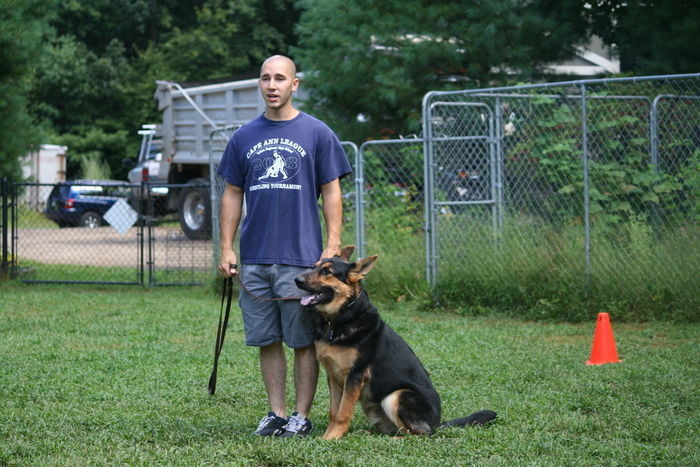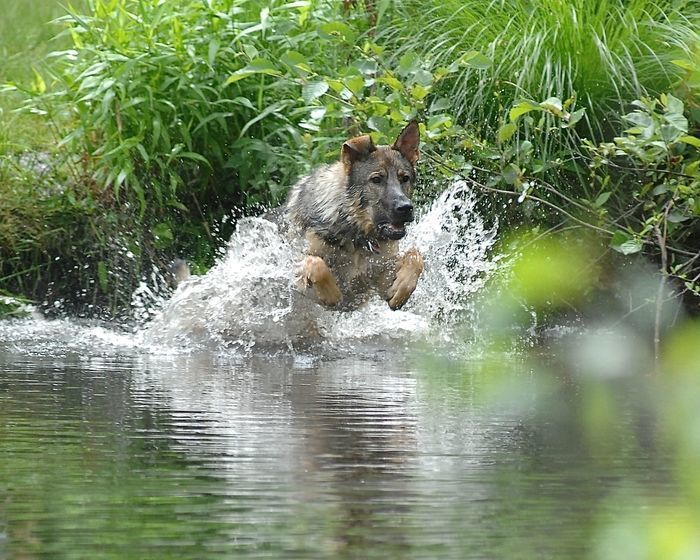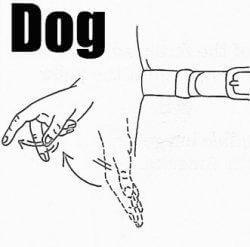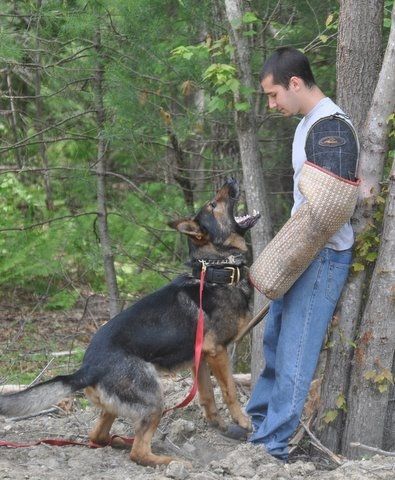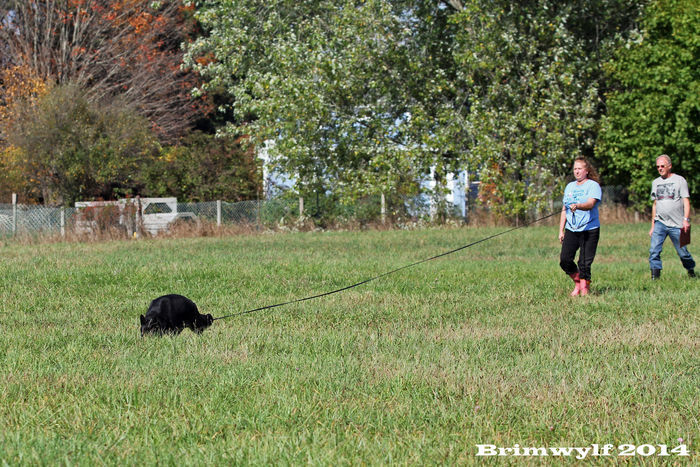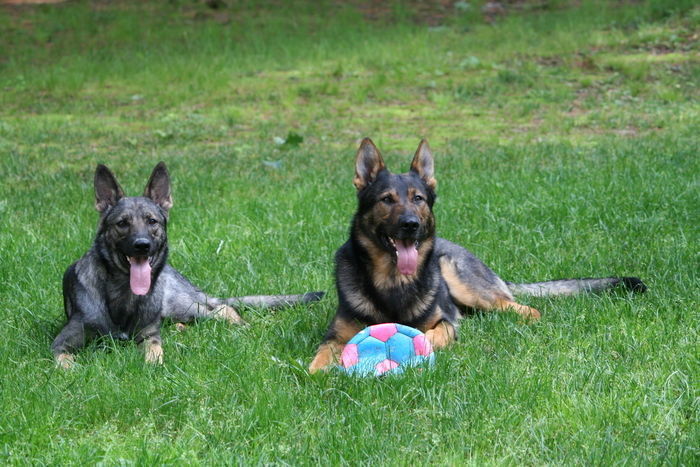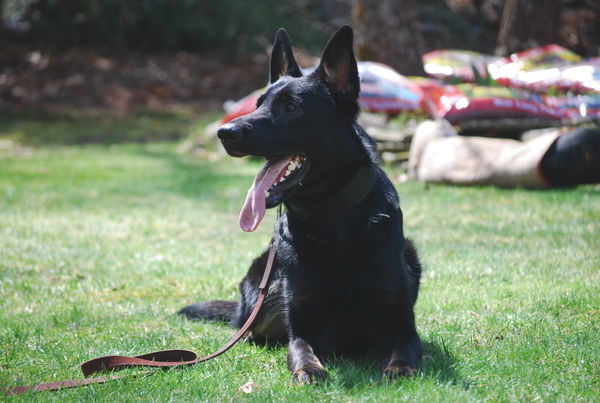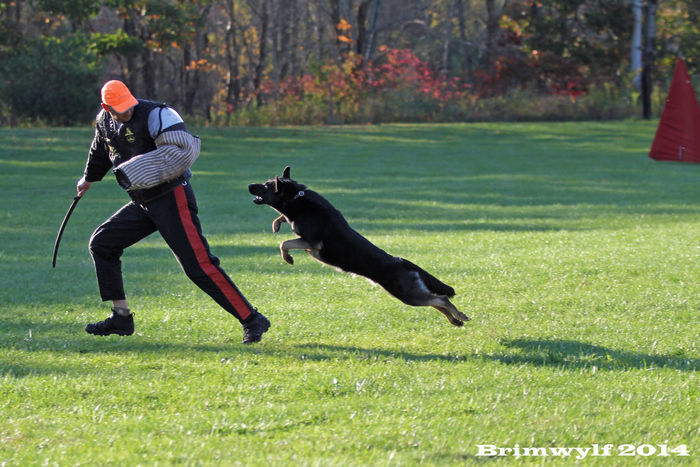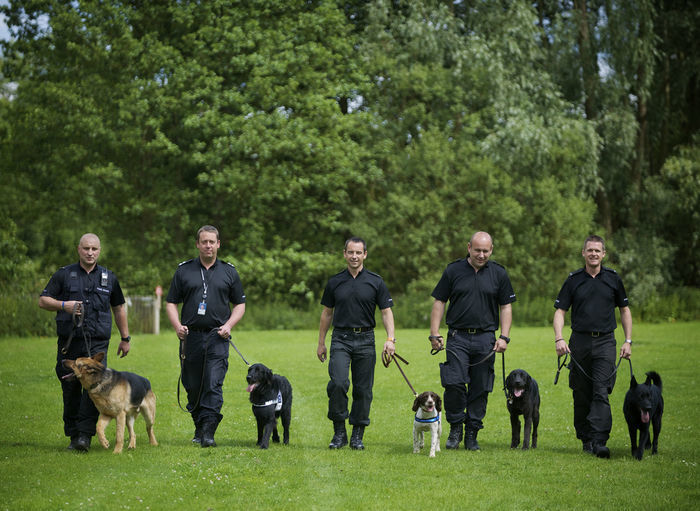Expert German Dog Commands; How To Train Puppies The Easy Way
The act of commanding your dog is nothing new…
But when it comes to training German dog commands to your puppy, there’s no better way quickly boost obedience while strengthening you and your canine companion’s bond.
Making your puppy listen using training tools (like prong collars) may be easier, sure. As is having a toy or treat in your hand 24/7 to use as a doggie bribe…
But if you’re like most German Shepherd puppy or other working dog breed owners, you prefer your dog listen to your voice alone, rather than rely on physical reward or negative correction!
Skip To Command List + Audio ExamplesYou may be thinking:
Yes! It would be nice for my words to matter more in training, but how does learning to command my dog in German make them want to obey me more consistently?
Great question!
By following this guide, you’ll learn:
- Why many dogs understand foreign languages better than English
- Other languages (besides German) you can use for this type of training
- Why segmenting commands into “performance” and “leisure” will save you hours of training
- The importance of “fail proof recall” and why it may save your dog’s life
- The real danger of not training your dog in two languages.
- How to start training your dog commands in German today!
- And yes, dog dancing video…
My goal in writing this guide is to help make communicating with your dog easier. But this “German Dog Command” guide is just that, a guide. There’s no “one size fits all” expert dog training tip or hack that’s going to guarantee perfect obedience from your puppy or adult dog every single time…
But by understanding the psychology behind WHY you should train your puppy a certain way, the HOW to get results part becomes much easier! As you read the 5 steps and stories below, think about you and your dog’s life together:
What obedience goals do you have? How can the steps in this article be applied to your own lifestyle?
Contents
- How To Easily Command Your Dog In Any Foreign Language (Especially German)
- Tip #1: Keep All Command Sounds Distinct From Each Other
- Tip #2: Establish Different Value Levels For Commands
- Tip #3: Commit To Teaching Your Puppy German And English
- Tip #4: Learn The Commands Even If You’re Not Training Schutzhund
- Tip #5: Practice With Your Dog
- Where Are German Commands Commonly Used?
How To Easily Command Your Dog In Any Foreign Language (Especially German)
The act of commanding a dog is nothing new…
Through training we intend to instill a sense of understanding between us and our canine counterpart using a shared language.
As a dog trainer, I’d like to think of that language as consisting of words (commands), I and my dog understand to mean the same thing; not in concept but in the carrying out of a physical maneuver (or to stop doing what it is they are doing).
Whether you use German, Czech or Dutch, or english, or otherwise, that act of commanding your dog is critical for dog training success.
Dogs have to listen.
Tip #1: Keep All Command Sounds Distinct From Each Other
Your dog needs to know the difference between one command and another. Otherwise, it’s impossible for them to distinguish the differences between any of your training…
How do we do this?
Easy!
Make sure all commands you give your dog are:
- Short
- Sharp
- Distinctive
- Loud enough to be heard
According to Arizona State University, it can take up to two full years and between 1,500 and 3,000 hours of training for a dog to be approved as a service dog! One of the main reasons training is a long process is because dogs key in on sounds not actual words, so it takes many training hours for your dog to distinguish between similar sound words, like sit and shit for instance.
So if it’s in our control to not use similar words as commands, then why not do so?
It’ll make training your German Shepherd puppy much easier!
Why Do People Train Their Dogs In Foreign Languages?
One functional reason owners train their dogs in foreign languages is to help differentiate between similar commands.
In the German language in particular, command terms are much more distinct than in English. This helps avoid confusion on the dog’s end. But beyond keeping these terms distinct from each other, there are a number of reasons people train their puppies other languages..
Tonality & Pronunciation Benefits
The tone used to speak in German and other common languages for dog training like Czech, Dutch, and Russian is much more crisp than English. This crispness helps dogs correctly differentiate between one directive and another, which increases their willingness to continue learning from you
Uniqueness
It’s no doubt that training your puppy in a language like German or Dutch is unique. You’ll definitely turn a few heads when you’re out in public or at the dog park communicating with your dog in a language everyone else can’t understand. The German word for “stay” is “bleib,” which just sounds much more unique (at least to Americans) than a simple “stay.”
Fun Factor
Many professional dog trainers train in German, but you don’t have to be a pro trainer to have fun teaching your dog! You just have to have a strong understanding of their behavior and focus on being their friend!
The fun factor of teaching your dog another language is a common reason people give it a try. Because if you’re having fun, it’ll rub off on your dog! The way you’re going about the training will foster feelings of affection instead of conflict. Over years of fun training, your dog will want to learn from and follow your lead.
It’s Challenging!
If you don’t speak German, then you’ll have to first learn part of the language before training your dog. Learning foreign languages (even if just a few simple commands) is a challenge that many people find fun.
It’s Rewarding!
When training progresses to the point where your dog understands you in multiple languages, you’ll certainly feel accomplished. And your feelings of accomplishment will certainly transfer to your dog! They’ll feel more accomplished because they’ll be able to more easily focus and obey you. At this point, you can introduce even more complex training methods and techniques without the need for strict correction.
What Languages Are Good For Canine Behavior Training?
German isn’t the only language that’s good for dog training. I’ve included a few other popular languages below:
German
Due to the popularity of Schutzhund and other dog sports in Germany, German has become the most popular language to teach your dog. Besides the German Shepherd Dog, the Rottweiler is a notable dog breed from Germany that you’ll hear being commanded in German.
Czech
Czech dog commands are similar to German-based commands. In fact, some dogs are trained in both German and Czech! The k9 mentioned in this 1994 article by Kent State University first came to the college with extensive training in both the German language and Czech language. Ultimately, the handler chose to continue training in German only because the language was easier.
Another interesting point from the Kent State article is that the dog handler notes a major benefit in German training as opposed to English language training.
Specifically for police k9s, commanding a dog in a foreign language like Czech or German helps on the job because “the perpetrator doesn’t know what he (Ed the dog) is going to do when they hear my order, so they’re scared.”
This reasoning can be applied to non-police work as well, which we’ll cover in the next section.
Dutch
Perhaps you’ve heard of the Dutch Shepherd?
When it comes to working dog breeds, German Shepherds and Dutch Shepherds are cousins! They’re both members of the herding group, and their mutual love for work makes them a popular choice for use as police k9s and military dogs. The high intelligence also makes them one of the best choices as family dogs.
Where Dutch Shepherds differ though, is in their energy level and size. Dutchies generally have higher energy levels than German Shepherds and, on average, grow to a be a smaller size as adults.
According to the UCL, Dutch is spoken by 23 million people worldwide, with 4 million speakers as a second language. It’s spoken across Eastern Europe, but most commonly heard in the Netherlands and Belgium where Dutch is the official language. Other countries with a considerable amount of Dutch speakers include Indonesia, South Africa, many Caribbean Islands, and Canada; who has almost a million speakers.
With so many speakers, it’s no wonder dutch dog commands are so common amongst dog owners.
What are some other breeds you’ll hear being commanded in Dutch?
Some other dog breeds with Dutch lineage include:
- Dutch Shepherd
- Bouvier des Flandres
- Kooikerhondje
Russian
Russia is a the world’s largest nation; over 8,000,000 square miles larger than the United States! And with such a large land mass comes lots of Russian speakers, so it’s no wonder why Russian is such a common language to use for dog commands.
Some Russian dog breeds include:
- Siberian Husky
- Borzoi
- Black Russian Terrier
- Russian Spaniel
French
Parlevouz-francais?
French isn’t just the language of love, it’s a popular language for dog training because of the Poodle’s popularity.
According to Stanley Coren’s list of intelligent dog breeds, Poodles are 2nd most intelligent dog breed in the world. They’re listed right behind the Border Collie (#1) and right in front of the German Shepherd Dog (#3)…
And like with German Shepherd training, many Poodle owners prefer to train their puppy in the dog’s native language.
The poodle comes in three size; miniature, standard, and giant. Other french dog breeds that may take well to French commands include:
- Poodle (all sizes)
- French Bulldog
- Malinois
- Great Dane
Sign Language
Above is how you say dog in sign language (source)
Commanding your dog using hand signals and other physical gestures is incredibly powerful from a functionality perspective. If you ever need to get your dog to obey you without using your voice, it’s important for them to understand even basic signals.
To accomplish this, you don’t necessarily even need to use sign language. Simple hand gestures the dog will understand are fine. And you may be wondering…
Can dogs really understand hand signal commands?
Absolutely! In fact, canines are faster at learning visual ques than they are at picking up verbal ques!
Important: Just make sure you give a 1/4-1/2 second pause after you give a verbal command is given before you use the hand gesture to help.
Treating hand gestures as a sign language for dogs of sorts will help your dog eventually associate your hand signal with the same voice command you use.
Tip #2: Establish Different Value Levels For Commands
Establishing different values for your commands is a quick way to boost the effectiveness of your training.
Consider these three different ways to use the directive “sit”:
- Please sit…
- Sit.
- SIT DOWN NOW!!!!!
As humans, we understand the differences between the three different ways to say “sit” above, but our dogs don’t.
Yes, dogs do understand basic differences in tonality. This is why yelling at a dog will (generally) cause them to obey at a higher rate, but you don’t want to yell at your dog. And we don’t want you yellling at your dog to make them obey either!
There’s gotta be a better way, right?
The way you can avoid needing to raise your voice in order to get compliance from your dog is to purposely train different commands for the different levels of compliance you desire. For example: use different words all together for “please sit…” and “SIT NOW!!!!”
Also, keep in mind: tone is the only variable you have to correct or command your dog when no training equipment is being used (the dog is off leash). If you are consistently raising your voice when you have the equipment to aid you, then you are doing yourself and your training a disservice because you’ll lose the surprise a change in tone can bring (when your really need it) if you squander the element of surprise by consistently raising your voice in training.
Clear Hierarchies Help You Keep Consistent Training Messages
Although you and I know the difference between “please sit” and “SIT NOW,” you dog does not…
So, separating your commands into two categories (performance and non-performance) commands will make training easier for not only you, but for your dog too. It will eliminate lots of frustration from your training sessions.
Performance Level Commands
Performance level commands are commands that must be taken seriously and performed quickly without fail.
They’re the “SIT NOW” or “FRONT, IMMEDIATELY” commands:
They come in handy when obedience is absolutely necessary.
In life-threatening situations, performance commands can save your canine’s life.
Training A Fail Proof Recall Command
A very common emergency command is the fail proof recall.
It’s a word you use to get your dog to come back to you under any circumstance.
Training this command on a long leash (lead) with distractions is especially helpful:
This should be practiced in a way that successful attempts are nearly 100% and the reward should be of very high value. Perhaps the only time you give lots of food is after obedience to this command. You want the reward for obeying this command to be higher in value than any other command, so when your dog hears it in a real life emergency situation, they recall the training and come back to you immediately (even if under serious duress).
Leisure Commands
Dogs are a major part of our everyday lives. And like requesting tasks from humans, it gets exhausting to be demanding for everything you need. Eventually, other humans will stop listening to you if you demand instant performance for every command you need, right?
Treat dogs the same way and dog training will feel much easier for both you and your pup! It’s one of the faster ways to make sure your German Shepherd becomes a great family dog.
Leisure (or non-performance) commands are those in which you don’t mind if the dog takes it’s time or gets comfortable before completing.
Like this:
Training Your Dog To Listen Quickly
In order to make this distinction between performance and leisure level terms, we use two different words for essentially the same physical maneuver. I recommend using German terms for the commands where you want your dog to listen and act immediately and English for the directives that are less serious.
During your training sessions, the only difference is that with the “performance level” we only reward “trys” that are completed quickly and with maximum understanding.
Important: DO NOT reward your dog if they don’t act immediately to the performance command! Simply restart the sequence and try the directive over again.
Compliance Example
We’ll use “lay down” as an example. In English, many trainers simply use “down, which is fine! The German word for lay down is “platz.” Platz is pronounced “plots.”
To split “lay down” into performance and leisure, we would use “down” (English) and “platz.” (German).
We like German for performance because the language is more guttural than English, it conveys a bit more urgency to the animal. When teaching the “down” we would allow the dog to lay crooked, slowly, with it’s hips to one side. Compliance within a few seconds of when the command was given is okay here. Your dog is allowed time to get comfortable! And as long as they get to a laying down position within a reasonable time, we reward the attempt.
On the contrary, when we use the directive “platz” we only reward, straight (sphinx like) downs, that are completed with quickness. The meaning of “quickness” varies depending on the stage of training your dog is at, but us “within a second” as the rule of thumb you’re aiming for.
Establishing different levels of commands is so important because over the course of your dog’s life, it’s almost a guarantee that situations will pop up where listening AND obeying is not only important, but critical. This is true whether you’re training your dog in German for the purposes of competing in canine sports like Schutzhund or for any other reason.
Critical Beyond Schutzhund Training
A common misconception is that teaching your dog in German is only important if you’re going to compete in Schutzhund or schutzhund-style competitions…
This couldn’t be further from the truth!
There’s real world benefits beyond just dog sport, some of which we mentioned above. For a more detailed explanation on why it’s important to use German commands for performance and English commands for leisure, check out tip #3 below.
Tip #3: Commit To Teaching Your Puppy German And English
Is it possible for a puppy to learn commands in multiple languages?
The short answer is yes. The longer answer is also very much yes…
Teaching your puppy new commands in both German and English is important for a number or reasons.
First, you get all the benefits of teaching your dog in German.
Second, you limit the downsides of your pup not knowing any English directives, which would be the case if you chose to train your puppy using only German terminology. They’d only be able to listen to YOU, and to everyone else…
“I’m too cool to listen to your silly commands…”
The more you teach your dog, their ability to learn from you increases. This is one of the best perks of constantly being a leader and teacher to your animal. The more your teachings lead your dog to life’s rewards, the more often they will look to you for guidance. At this point, learning becomes easier for your dog because he or she starts to understand your teaching process, not just commands.
BTW: this is especially true with intelligent working breeds like the German Shepherd
Benefits Of Teaching In English
Whenever training your dog, it’s important to consider their life beyond just you. Though it’s ideal to think that you’ll be the only person to ever give your canine a command, it’s simply not the case.
What if you go on vacation and need someone to watch the pup?
What if there’s an emergency?
If your dog doesn’t know any words in English, you’re leaving the caretaker in a position of significant weakness. Because if they’re unable to give your dog commands because your dog only knows German, then the experience will be a negative one for you, your dog sitter, and your dog…
Benefits Of Teaching In German (Or Any Other Language)
In tip #1, we talked about the reasons many dog owners choose to teach commands in foreign languages like German, Dutch, Russian, and French. The differences in tonality and pronunciation makes it easier for your dog to understand. And if they understand easier, they’ll learn faster! Training will be more fun and productive, which helps clear the path towards obedience.
Another benefit of training your puppy in German is that other people can’t give your dog performance commands on a whim. This helps establish YOU as the handler in the dog’s eyes because you’re the only one who gives commands that must be obeyed immediately.
Should I Start Training My Puppy In German Or English First?
Start training your puppy in English because you shouldn’t be expecting perfect compliance anyway. Once your puppy has a few key terms under his or her belt, then you can begin to introduce more serious, performance oriented versions in German or another language.
Tip #4: Learn The Commands Even If You’re Not Training Schutzhund
You don’t need to commit to Schutzhund training in order to train your dog non-English commands!
With all this talk of the reasons you should teach your dog in German, you’re probably thinking “Great! I know I need to train some German words but how do I learn? And which commands are most important?”
There are great questions!
The learning process is just as important for you as it is for your dog. Below are some resources you can use to learn German dog commands. Start with the list of commands below and if you’d like to go deeper into the learning process, check out some of the other resources.
The Ultimate Learning List
Without further ado…
| English Command | German Command | Pronunciation | Meaning |
|---|---|---|---|
| Bad Dog | Schlechte Hund | (sch-lek-ta Hoond) | Bad Dog |
| Bring / Fetch | Bring | (Brring) | Fetch |
| Come | Komm | (Komm) | Come |
| Crate | Box | (Box) | Crate |
| Down | Platz | (Plots) | Down |
| Go | Gey | (Gay) | Go |
| Good Dog | Braver Hund | (Brahfer Hoond) | Good Dog |
| Heel | Fuss | (Foos) | Heel |
| Here | Hier | (Heer) | Here |
| Hold | Fass | (Fahs) | Attack Take hold |
| Jump | Hopp/Hupf | (Hup) | Up Jump |
| Look/Watch | Achtung | (Ahk-toong') | Watch Attention |
| No | Nein | (Nine) | No |
| Out | Aus | (Ows) | Out Drop It Let Go |
| Quiet | Ruhig | (Roo-ig) | Quiet |
| Run | Voraus | (For-ows) | Go forward Run out |
| Search | Such | (Zook) | Track |
| Search | Voran | (For-ahn) | Go On Blind Search |
| Sit | Sitz | (Zetz) | Sit |
| Speak | Gib Laut | (Gib Lawt) | Bark |
| Stand | Steh | (Shtay) | Stand |
| Stay | Bleib | (Blibe) | Stay |
| Stop | Pfui | (Foo-ey) | Shame Stop That |
| Very Good | So Ist Brave | (Zo ist Brahv) | Well Done |
| Watch/Guard | Pass auf | (Pahs owf) | Pay attention / Watch |
Audio Examples for Pronunciation
You can use the player below while training to practice pronunciation.
Just click each term to hear the audio!
How many commands are needed?
Depends on the animal’s life on a day-to-day basis…
Does he or she have a job or are they a family dog who lives at home, and views their job as playing with the kids or fetching a ball?
You’ll, of course, need to train more commands if your puppy is on track to become a working canine.
A campus security dog at California State University’s Northridge campus started with only 20 commands, though.
In our German Shepherd temperament article, I talked about why mental stimulation is just as important as physical exercise for your dog’s wellbeing.
Search For More And Translate Your Own
It’s your life, so you’re free to attack training the way you want!
The list above won’t cover all the commands you’ll likely want to train your German Shepherd, Rottweiler, or other working dog…
You’ll likely want to jump into more advanced training using your own terms. Use one of these free German to English translators to add more commands to your training repertoire:
Google Translate
Google Translate is a free service you can use for English to German translations, or English to any other language, for that matter. Click here to give Google Translate a try.
IM Translate
If you don’t like Google Translate’s interface, you can use IM Translator instead. It’s one of the more popular English to German translators online. Click here to use the English to German version of IM Translator.
Flash Cards
You can make flash cards to keep in your pocket for reference during training. This strategy is helpful if you’re a visual learner or if you have a partner or friend to practice with. The better you know the commands, the more confident you’ll be when training your dog.
But remember: Confidence (and fun) is everything!
Tip #5: Practice With Your Dog
The fun continues…
For any puppy, it’s important for learning to be fun because all canines learn best when things feel like a game. That’s why tennis balls (or a schutzhund-strength flirt pole) sometimes work better as training aids than treats, no matter how much the dog loves food!
At Home
Even if you’re busy, you’re not too busy to practice training your dog German commands at home. It’s a great learning environment because, for the most part, you get to dictate the distractions. You can make the environment very distracting or not distracting at all, depending on your dog’s level of training.
A great time to practice commanding your dog is while doing general household tasks. Have your dog follow you around the house as you’re raking leaves, for example. Keep a pocket filled with treats and a click around your wrist, and every once in a while give a command then reward accordingly.
During Play
As discussed in the temperament article, play time is a great time for training because dogs (and humans) make the strongest connection for learning during play! It gives you as the handler an opportunity to learn about your dog’s drive and start to understand it. In the long run, this makes you a better trainer!
Around Town
Whether you live in Germany, Massachusetts, or even Sacramento, you’ll benefit from getting your dog out of the house and training in new environments. For most effective training, it’s important to alternate between new and old environments as well as distracting and less distracting ones.
- Keep All Command Sounds Distinct From Each Other
- Establish Different Value Levels for Commands
- Commit To Teaching Your Puppy Both German And English
- Learn The Commands
- Practice With Your Dog
Where Are German Commands Commonly Used?
You’ll hear dogs being directed in German in a variety of places.
Below are the most common:
Germany
Obvious, but I had to!
Police K9s
Police K9 commands are serious business. It’s critical for police dogs to listen to their handlers because if they don’t, there are real-life downsides. Police dogs go through lots of training to help make sure they’re ready for the high-stress job of being a police dog.
Military K9s
The United States military uses police dogs for a number of jobs!
According to the San Antonio Magazine, there are over 2,500 dogs currently serving in the military. Out of the 2,500, roughly 700 of them are currently deployed overseas serving America.
And if you’re wondering.. Training high-level working canines isn’t cheap! According to expert dog training company Robinson Dog Training, the average fully trained bomb detection dog costs $150,000.
Other Working Dogs
Over the last few years, dogs with jobs have been getting more an more publicity. From service dogs for wounded veterans to seeing eye dogs, to search and rescue dogs, to cancer detection dogs, there’s lots of places you’ll hear dogs being commanded in German in order for their handler to get a higher rate of compliance.
In Dog Sports
Chances are you’re not reading this article to learn how to train a dog as a police k9 or a military dog. Besides training for better compliance during everyday life activities, the most common use for German commands are dog sports like Schutzhund.
Schutzhund
Schutzhund is a dog sport that was in the recent past (and still in a lot of circles) used as the breed test for German Shepherds around the globe.
All prospective breeding dogs were required to achieve at least a Schutzhund 1 [SCHH 1, SCH 1] title, which is now referred to as IPO 1. Recently, Schutzhund has been “changed” from a breed test into a sport. Naturally, this has changed Schutzhund a bit…
Where it was once necessary to simply complete the tasks proficiently, many people now strive for higher performance with-in the various segments of the sport.
The three stages of a Schutzhund competition are:
- Tracking (foot-step tracking)
- Obedience (with a bit of agility)
- Protection work (the ability to seek out and subdue a threat).
All segments are scored on a scale of 0-100, with 100 being perfect.
A score of 70 in tracking and in obedience are considered “passing” scores. But in protection, the passing score is 80/100 due to the seriousness of the task at hand and requirement of the dog to listen while being high in drive and aggressive.
Other Dog Competitions
Schutzhund isn’t the only dog sport you’ll hear lots of German yelling in!
Some other dog sports include:
- Agility
- Tracking
- Obedience
- Hunting
- Search and rescue
- Dock Diving
- Dog Dancing…..
- Fly Ball
- Disc Dog
- Herding
…yes, dog dancing.
We’ll finish with a video of that. The 2012 dog dancing finals:
As you start the journey towards training your puppy German dog commands, never forget the psychology behind the training. As is often the case with dogs, the WHY behind your training tactics and strategies is often much more important than the HOW.
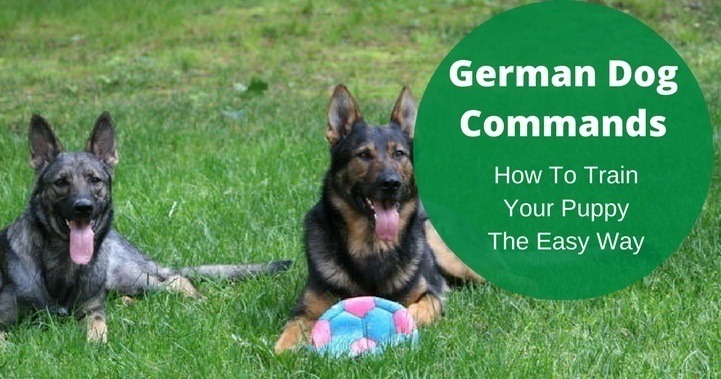

About the Author Brandon Hayes
Founder of Hayes Haus Kennels, Brandon Hayes grew up in Massachusetts and is no stranger to the dog world. He's been working as a dog trainer for 15+ years and breeding German Shepherd Dogs since 2009. In his free time, he enjoys coaching wresting at Triton High School.

